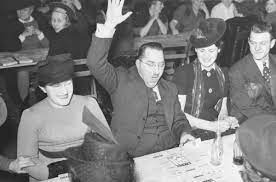Bingo is a very popular game which dates back to the 16th century. It was played by the Italian society called the ‘Lo Giuoco del Lotto D’Italia’ which was made up of nearly all Italian families. This game was played with a circular board containing numbered pockets and a number of numbered balls kept in a covered box. The ‘Bulla Del Lotto D’Italia’ were drawn once a week and was supposed to contain the results of that draw right up to the 18th century.
This game however soon developed into an individual gaming machine, primitive versions of which were created in the 17th century. These ‘Gaming Machines’ were crude but very understandable and simple to play. They involved three or more persons, a deck of playing cards and a ‘Dealer’. The ‘dealer’ would keep a ‘boys’ room’ where the boys would be waited for their turn to draw the cards. A small token was also placed here by the ‘boys’ owner, to indicate that the token was not used to buy the cards. This simple automatic gaming device was eventually replaced by the ‘King James I’ Greek Contriver, which became the most widely used gaming machine in the world.
18th century
‘Chemin de Fer’ is believed to have been invented by Jean le Rond d’Alembert, a French mathematician, in 17th century France. This game was played with a single deck of playing cards.
‘Queen of Sheba’ is another well known form of the Chemin de Fer. It is a high ranking form of the popular card game of Tarot.
‘Pochen’ is a mid 16th century German game which had a small numbered cards and a set of five community cards. The “ley-okers” were used in this game.
In the 17th century, the German childrens card game “Pochen” was brought into the United States. This version of Pochen is now commonly called “Crazy Eights” and was Virginia Pick’s Idea.
‘Bluffing’ was introduced by the British Privy Council in the 17th century.
These games were all played with cards. The cards used at certain times of the game were for value and high cards such as jack, queen and king were expected to bring the player benefits. All cards however were cards of the same rank.
When playing cards at that time, it was usual to bet the pocket cards orchestra. The game of cheval or faro was played with a pack of four cards which were all facing down and the player had to guess what the cards were in the hands of the opposing player and the cards in his own hand. The cards were in a readiness order as to how the game would proceed.
Once the cards were dealt and the first round of betting had taken place, the “current round” began. The player to the left of the Dealer would bet, the player to the left of him would have to make a forced bet called a “Dewacasino” and the player to the left of him would bet an amount known as a “pochen”. This continued on until either the player won or until there was a dead hand.
Dead hands wereucky – the term referred to a hand that had not been played out Yet. It is very similar to lucky but there was no raise and the player had no options. The pot was carried over to the next round. If a player carried over the pot it means they win that round.
Pochen or Blooch, were all playing for the round and had to bet money in to the pot, which was located in the center of the table. It was a established custom for players to bet in the pot. The game of poker was not that popular that it was not worth it for the banker to stay in the game. The game was a “checking game” the banker had to wait for all the bets in before he could pay the winner.
As the game evolved, it became more and more popular and was becoming a casino hit.
The “Cthulah” case settled in 1744, possibly as a result of the French Revolution.
The Liberty Bell machine turned the game from a casino related amusement into a monetary incentive.
These machines were all original versions, some are still around, but now they are either reserved for significant events or are a curiosity item.
Unlike the numbered slots that are armed with a lever on the side, all of these slots had a button pushed down which was a substitute for the lever.
Nowadays the machines are prized by collectors. The original versions are obtainable, but the modern ones are prized as collector’s pieces.
Video slots have been around since the 1970’s.
